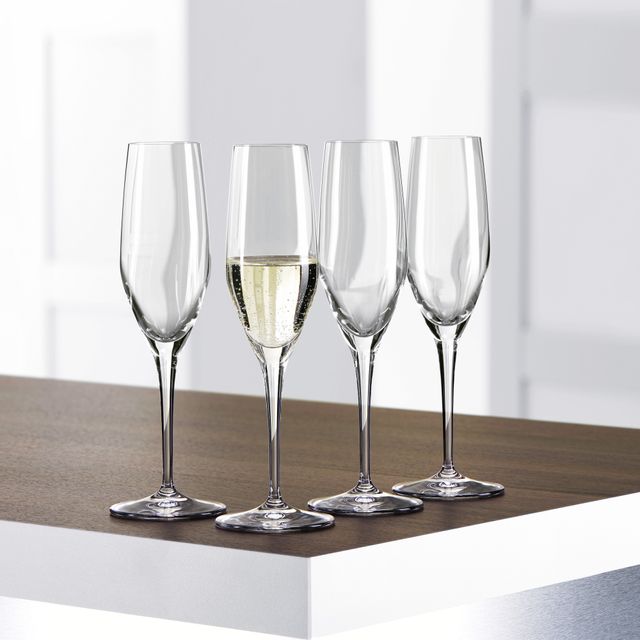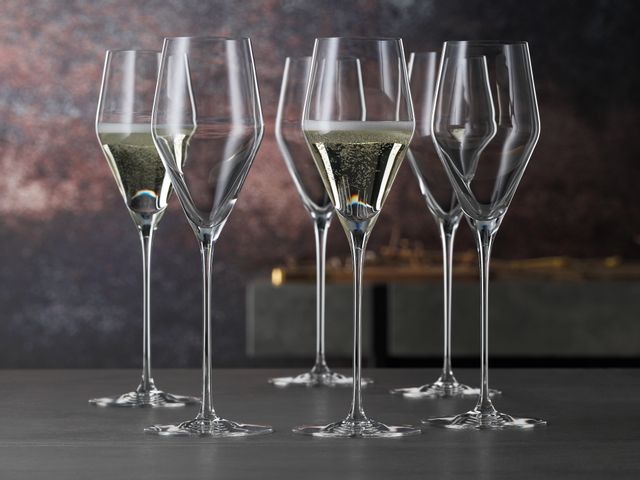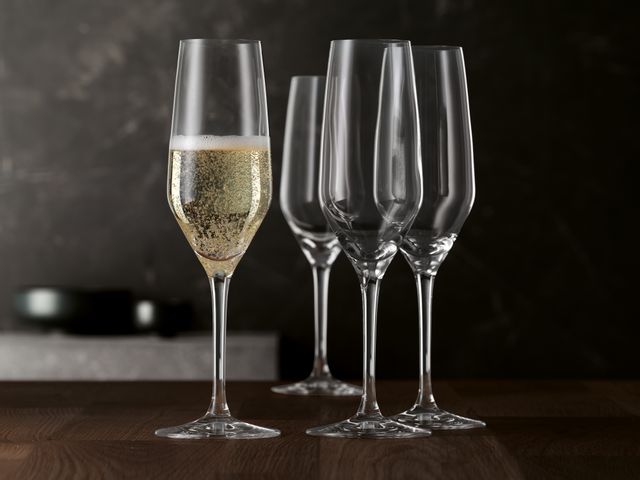Pop, Fizz, Clink
The Magic of Champagne

When it comes to celebrations, there's one type of wine that fits the bill better than any other. Champagne has a timeless allure and effervescent charm synonymous with celebrations, milestones, and moments of extravagance. Join us as we delve into the fascinating world of this wine, exploring its history, production, characteristics, and the art of pairing it with food.

The history of Champagne - a royal turnaround in fortunes
The history of Champagne is as effervescent as the wine itself. Wine has been produced in the Champagne region of France since the days of the Roman Empire, but the story of the fizzy phenomenon we know today takes us back to the 17th century.
A happy accident
Sparkling Champagne had previously been produced by accident! Cold winters in the Champagne region would often put a halt to the fermentation process of these wines. Once temperatures began to rise again after the winter, a second fermentation would occur inside the bottle, causing carbon dioxide bubbles to build in the wine. This CO2 build-up is what creates Champagne's unmistakable effervescence we know and love today. Winemakers at the time, however, were less fond of this little accident; the increase in pressure caused by the CO2 would often cause the wine bottles to explode, earning Champagne the nickname "le vin du diable" (the devil's wine.)
Royal intervention
Pre 17th-century, these sparkling Champagne wines were considered a novel bit of fun, but ultimately faulty. However, Champagne's fortunes changed in a big way when it became the drink of choice for French royalty and nobility, who were fond of its quirky effervescence. Subsequent royalty maintained this love for the drink, which helped cement Champagne's status as a wine symbolizing luxury and status. Deliberate production of sparkling Champagne grew in popularity, and so began the journey that has led to Champagne becoming the iconic drink it is today.
How Champagne developed its distinctive characteristics
It was also during the 17th century that Champagne began to develop other notable features we associate with it today. Before this century, wine from the Champagne region was murky and unremarkable. However, thanks to the likes of Benedictine monk Dom Pérignon, who made crucial advancements in winemaking, including developing the traditional Champagne press to produce clearer wines and improving the art of blending different grape varieties, Champagne wines developed distinctive qualities. While the story of Dom Perignon inventing Champagne is almost certainly not true, his work and the work of others laid the foundation for what would become one of the world's most celebrated beverages.
Today, Champagne is enjoyed worldwide for celebrations and as a symbol of elegance and sophistication. Its appeal extends beyond French borders, with Champagne houses producing millions of bottles annually to meet global demand. Like other notable wines, it even has an international day named after it! Champagne Day takes place annually on the 4th Friday of October and sees people from around the world celebrate all things Champagne.

Champagne's production process
We've clarified how Champagne was somewhat stumbled upon before production techniques became more deliberate and refined, but how is it made today?
Champagne's distinctive effervescence arises from its production method known as the méthode traditionelle. The groundwork for this method came in the late 17th century, when English physician and scientist Christopher Merret documented the addition of sugar to still wines to create the secondary fermentation that puts the sparkle in sparkling wines. Here's a brief overview of the process:
- Harvest: The grapes for making Champagne are hand-picked between August and October before being carefully pressed to keep the juice clear. Champagne is typically made from a blend of Chardonnay, Pinot Noir, and Pinot Meunier grapes, although there are variations such as Blanc de Blancs (100% Chardonnay) and Blanc de Noirs (only red grape varieties).
- First fermentation: The base wine is produced through a standard fermentation process, converting grape sugars into alcohol.
- Blending: Different wines from various grape varieties and vintages are carefully blended to create a consistent house style.
- Second fermentation: The blended wine is bottled with a mixture of sugar and yeast, known as the liqueur de tirage. This initiates a second fermentation within the bottle, which causes a build-up of CO2 that cannot escape due to the bottle being sealed, creating Champagne's trademark effervescence.
- Aging: The bottles are stored horizontally in cellars and left to age on the lees for an extended period, ranging from several months to many years. The longer the Champagne ages, the more of a toasty, yeasty character it will exhibit.
- Riddling: Bottles are held at an upside-down angle and gradually rotated day by day. Doing this encourages yeast sediment to settle in the neck of the bottle, from where it can be removed.
- Disgorgement: While kept upside-down, the necks of the bottles are frozen, creating a plug of frozen wine containing the dead yeast cells. The yeast sediment is then expelled by taking the top off the bottle, which causes the pressure built by the CO2 to force out the plug of yeasty wine, leaving a clear wine behind.
- The dosage: This process involves adding a mixture of white wine, brandy, and sugar (the dosage) to the Champagne to alter its sweetness.
- Corking and Aging: A cork is inserted and wired down to contain and retain the high pressure and effervescence given to the wine by the high concentration of CO2.
So, the method is a little more refined than the initial process of Champagnes accidentally going through a second fermentation following cold winters!

Characteristics of Champagne
Once all that is done, we have our Champagne ready for consumption. But how does it smell, feel, and taste? Champagne boasts a remarkable range of flavors and aromas that make it a captivating drink. Common characteristics include:
- High acidity: This is a trademark of Champagne and other sparkling wine variations and is vital for giving freshness and balance to the wine.
- Fruity aromas: Common aromas displayed by Champagnes include citrus, green apple, and pear. That said, depending on the grape varieties used and the aging process, Champagne can exhibit an array of other aromas, including brioche, toast, and floral notes. Generally, the older the Champagne, the more rich, toasted flavors you'll likely encounter.
- Flavors: The palate of Champagne often features flavors like green apple, lemon zest, white peach, and hints of minerals. With age, these flavors can evolve into richer, nuttier notes.
- Texture: Champagne's texture can range from light and crisp to creamy and luxurious, making it suitable for a variety of occasions and pairings.
With such a range of characteristics, enjoying Champagne from a glass that appropriately communicates these qualities to your nose and palate is crucial. You can learn all about how we specially craft our Spiegelau Champagne flutes and Champagne glasses to elevate your Champagne sipping experience by checking out our blog on the science of Champagne glasses.

Pairing Champagne with Food
Like any wine, you can elevate your Champagne experience by pairing it with foods that complement its qualities. Its versatility, acidity, and effervescence make it an excellent companion for a wide range of dishes. Here are some pairing suggestions:
- Oysters: The briny freshness of oysters harmonizes beautifully with the crisp acidity of Champagne. If oysters aren't to your liking, several other types of shellfish are also worth pairing with your Champagne.
- Sushi and Sashimi: The delicate flavors of raw fish are enhanced by Champagne's clean and refreshing profile, with neither party overwhelming the other.
- Creamy Dishes: Creamy pasta, risottos, and sauces benefit from Champagne's effervescence, which cuts through the richness of these meals to keep your palate refreshed and lifted.
- Cheese: Champagne pairs well with numerous cheeses, from soft, creamy Brie to aged, nutty Gruyère. When selecting your cheese, we recommend sticking to milder options, as rich cheeses such as stilton can overwhelm the delicate flavors of your Champagne.
- Desserts: Champagne can be enjoyed with desserts, particularly those that aren't overly sweet. For a balanced dessert and wine pairing, try it with fruit tarts, shortcakes, or light custards.
Champagne is a wine of celebration, history, and elegance. With a journey that saw it go from its accidental beginnings in the Champagne region of France to its status as a global symbol of luxury and celebration, Champagne has woven itself into the fabric of our most memorable moments. Its unique production method, bright characteristics, and versatility in pairing with food make it a truly exceptional beverage worthy of enjoyment by anyone from the Champagne connoisseur to the casual wine drinker. Santé!
Locations